Jerusalem

Jerusalem is not only one of the most beautiful cities it is also one of the most contested city in the world. This is the heart of the Holy Land, where the Jews raised the First Temple to keep the Ark of the Covenant safe, where Jesus was crucified and rose again and where the Prophet Muhammad ascended to heaven to receive God's word.
Praised by Jews, Christians and Muslims, Temple Mount or Haram Al-Sharif is a sacred site for all three faiths. Jerusalem's most iconic landmark, the Dome of the Rock is where the sacred stone is located and where both Jews and Muslims believe Abraham offered his son to God and where Muslims believe the Prophet Muhammad began his journey to heaven. On the southern side of the Mount, you will find the oldest Mosque in the world the Al-Aqsa Mosque.
The Western Wall is the surviving retaining wall of Jerusalem's First Temple. Commonly called the Wailing Wall due to the people's laments for the loss of the Temple in 70 AD, it is now the holiest site in Judaism and has been a place of pilgrimage for the Jewish people. A major feature for history buffs is the Jerusalem Archaeological Park, where archaeologists have unearthed fascinating remnants of Old Jerusalem. The Western Wall Tunnels, take you under the city and back to the level of the original city, should not be missed.
Yad Vashem (Hill of Remembrance) is Israel's major Holocaust Memorial. In the main part of the building, the Hall of Remembrance lists the names of the Nazi death camps set into the floor and an eternal flame burns in memory of the dead. Off the main hall there is a room, which contains the victim's names, a photographic exhibition, a children's memorial and an art museum with work produced by inmates from the concentration camps.
The Christian Quarter of the Old City runs north from the Jaffa Gate and is focused around the Church of the Holy Sepulchre and is said to have been built on the site where Jesus was crucified. The site for the Church was picked by Saint Helena, the mother of Constantine the Great during her tour of the Holy Land. She was the one to announce to the Byzantine world that this spot was the Calvary or Golgotha of the Gospels. The Church’s interior is a beautiful piece of religious architecture. This is the finish point for the Via Dolorosa pilgrimage and the last five Stations of the Cross are within the Church of the Holy Sepulchre itself.
For many Christian the Via Dolorosa (Way of Sorrow) is the highlight when visiting Jerusalem. This walk follows the route of Jesus Christ after his condemnation as he bears his cross towards execution at Calvary. The course of the Via Dolorosa is marked by the fourteen Stations of the Cross, some of which are based on the Gospels' accounts and some on tradition. Of particular interest along the way is the Chapel of the Flagellation (2nd station), built on the site where Jesus is believed to have been flogged.
More commonly referred to as the Tower of David, the Citadel actually has no connection with David, having been erected by King Herod to protect the Palace he built in approximately 24 B.C. Inside is the Tower of David Museum, you can see the story of Jerusalem along with permanent displays of archaeological exhibits. A climb to the Citadel's roof, will reward you with one of the best views over the Old City. In the evening there is a Sound and Light show with visuals projected onto the city walls.
Moving south from the Citadel, Armenian Patriarchate Road is the main street of the Old City's tiny Armenian Quarter. Within its narrow lanes are the St. James Cathedral and St. Mark's Chapel. Armenians have been part of Jerusalem's community since the 5th Century with many more arriving during the Ottoman era and after the Armenian massacres in Turkey during the early 20th Century.
The most vibrant district is the Muslim Quarter, which is home to the best Souk shopping in the Old City. Running from the Damascus Gate through to the Old City there are plenty of surviving remnants of Mamluk architecture, which line the streets including the 14th Century Khan al-Sultan.
Outside the Old City's Damascus Gate is Jerusalem's mostly Arab neighbourhood of East Jerusalem. Within the gardens at the foot of the wall, is Solomon's Quarries, a cave system that extends under the Old City. According to ancient tradition, the stone for Jerusalem's First Temple was quarried from here. The cave is also known as Zedekiah's Grotto as in Jewish tradition, Zedekiah, the last King of Judah, hid here from the Babylonian forces in 587 B.C.
Overloaded with Churches and home to the oldest continually used cemetery in the world, the Mount of Olives holds particular interest to religious pilgrims to Jerusalem. This sacred hill is believed to be the place where God began rising the dead on Judgement Day. For Christian believers, this is also where Jesus ascended to heaven after his crucifixion and subsequent resurrection. The Church of the Ascension on the top of the Mount dates back to 1910.
One of the oldest areas in Jerusalem is the Kidron Valley, situated between the Mount of Olives and Mount Zion. Both Jews and Muslims believe that the Last Judgement will take place here, a rope will extend from the battlements of the Temple Mount, over the valley to the Mount of Olives and the righteous will cross over, supported by their guardian angels, while the sinners will be cast down into damnation.
Mount Zion is home to Jewish and Muslim Shrines as well as a number of Churches. Dating back to the Byzantine Age, Mount Zion has been revered as the place where Christ celebrated the Last Supper and where the Virgin Mary spent the last years of her life. For Jews, Mount Zion's importance stems from this being the place of King David's Tomb. Climb up the stairs from the Tomb's courtyard and you will come to the Last Supper Room, which has served as both Church and a Mosque throughout its long history.
Opened in 1965, this museum complex is the only place in the country that collects and displays both archaeological finds and art. The Shrine of the Book displays Israel's portion of the Dead Sea Scrolls, which were unearthed in the Dead Sea area during the 1940’s (the rest of the scrolls are displayed in Amman's Citadel Hill Museum in Jordan). In the Judaica wing there are displays of sacred Jewish art and ethnographic exhibits from Jewish life in various countries. The archaeological wing contains fascinating exhibits from the early days of settlement through to the Romans, and the Art wing houses a collection of works by Israeli painters as well as art by Renoir, Gauguin and Van Gogh.
Mount Herzl commemorates the founder of Zionism. The remains of Theodor Herzl were brought to Israel in 1949 from Austria and were interned in a free standing sarcophagus on the summit of Mount Herzl. Close to the main entrance is the Herzl Museum with a reconstruction of Herzl's study and library.
